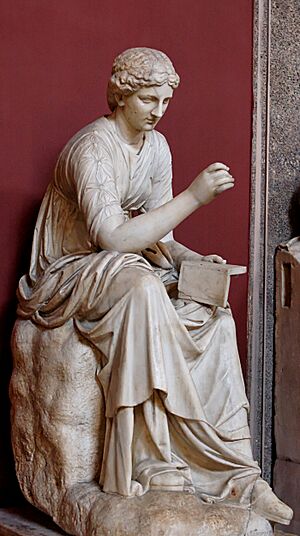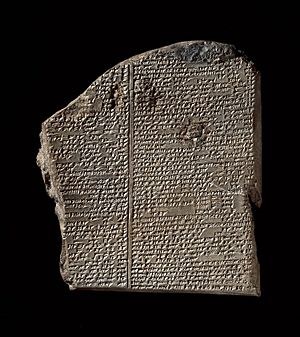History of poetry facts for kids
Imagine a time before writing! Poetry probably started as spoken words. Early poems were often sung or spoken. People used them to remember important stories, family histories, and rules. Poetry and music have always been close. The first poems were often hymns or chants. So, poetry is a way of using words creatively.
Old poems tell us many things. They include prayers, religious stories, and historical accounts. You can also find instructions for daily life, love songs, and fictional tales.
Many experts believe that early writing shows signs of older spoken traditions. This includes using repeated phrases. A rhythmic and repeating form made long stories easier to remember. This was very helpful before writing was common. So, ancient works like the Vedas (around 1500–1000 BCE) and the Odyssey (around 800–675 BCE) were first created as poems. Poetry appears in the oldest records of most cultures. You can find poetic pieces on ancient stones and monuments.
Contents
The Oldest Poems Ever Found
The oldest known story poem is Tale of the Shipwrecked Sailor. It was written in Hieratic script around 2500 BCE. Some experts say the Epic of Gilgamesh is the oldest. It was written in cuneiform. However, The Tale of the Shipwrecked Sailor likely came first, about 500 years earlier.
Other very old epic poems include the Greek Iliad and Odyssey. From India, there are the Sanskrit epics Ramayana and Mahabharata. Some scholars think the Mahabharata or the Tibetan Epic of King Gesar might be the longest epic poem ever.
What Makes Poetry Special?
Ancient thinkers wanted to understand what makes poetry unique. They also wanted to know what makes a poem good. This led to the study of "poetics", which is about the beauty and rules of poetry. Some old societies, like the Chinese, created lists of important poems. These poems were used in ceremonies and were also seen as beautiful.
The purpose of a poem is very important to its style. For example, poems that record history, like the Epic of Gilgamesh or Ferdowsi's Shahnameh, are long stories. Poems used for religious services, like hymns or psalms, often sound inspiring. Sad poems or tragedies are meant to make you feel strong emotions. Poetry can also be used in music, speeches, political talks, or even funny nursery rhymes.
Ancient African Poetry
Africa has a long history of poetry, going back to ancient times. People created hunting poems. They also developed praise poems and sad poems for courts. This happened in the empires along the Nile, Niger, and Volta rivers.
Some of the earliest written poems in Africa are the Pyramid Texts. These were written around 25th century BCE. The Epic of Sundiata is a famous example of court poetry by storytellers called griots. In African cultures, performance poetry was a big part of theater. This theater was present in all parts of life before colonial times. These performances had many uses, like political, educational, spiritual, and entertainment.
Poetics were part of these theatrical shows. Local artists, linguists, and historians performed them. They used instruments like the kora, xalam, mbira, and djembe drum. Drumming for music is different from the talking drum. The talking drum is a special way to communicate. It uses sounds that copy speech to send messages.
Classical and Early Western Poetry

Classical thinkers used categories to define and judge poetry. For example, Aristotle's Poetics describes three main types of poetry: epic, comic, and tragic. He also set rules for what makes the best poetry in each type. Later experts identified three major types: Epic poetry (long stories), lyric poetry (expressing feelings), and dramatic poetry (for plays). Aristotle's ideas were very important in the Middle East during the Islamic Golden Age. They also influenced Europe during the Renaissance.
Later, poets and thinkers often compared poetry to prose (normal writing). Prose was seen as writing that explains things logically. During the Romantic period, many old works were rediscovered. There was also a big increase in translating poems.
Chinese Poetry: A Rich History
The Classic of Poetry is the oldest collection of Chinese poems and songs. It is also known as the Odes or Poetry. This collection has 305 poems and songs. They date from the 11th to the 7th century BCE. The way Classical Chinese poetry developed involves both written and spoken traditions. These are usually linked to different Chinese Dynastic Eras.
The poems saved in written form are called poetic literature. But there were also traditions of spoken poetry, known as folk poems or ballads. Some of these folk poems were later written down. Folk poems are usually anonymous. They might have been changed a bit when they were written down. Besides the Classic of Poetry (or Shijing), another early text is the Songs of the South (or Chuci). Some individual poems or pieces also exist in other old writings.
Poetry Today
Modern poetry generally started in the early 1900s and continues today. Famous American poets who write in English include T.S. Eliot, Robert Frost, Wallace Stevens, Maya Angelou, June Jordan, Allen Ginsberg, and Nobel Prize winner Louise Glück. Modern epic poets include Ezra Pound, H.D., Derek Walcott, and Giannina Braschi. Today, poets like Joy Harjo, Kevin Young (poet), and Natasha Trethewey write lyric poetry.
Poetry is still used to share information. Many Americans know the rhyme: "In 1492, Columbus sailed the ocean blue." An alphabet song teaches the letters. Another rhyme tells us the names and lengths of the months. Some writers believe poetry started with songs. Many things that make poetry special, like rhythm, rhyme, and strong feelings, seem to come from trying to fit words to music.
In Europe, the oldest surviving poems are the epics by Homer and Hesiod. These poems were meant to be recited or chanted with music. They were not pure songs. Another idea is that rhythm and repeated phrases helped people remember and retell poems.
In societies without writing, poems were made for performances. The exact words of poems could change a bit. When writing was invented, the poem's content became fixed to the written version. Poets then started writing for a reader who wasn't there. The invention of printing sped up this change. Poets began writing more for the eye than for the ear.
Lyric Poetry: Expressing Feelings
Lyric poetry became popular around the 19th century. This was helped by radio, which could broadcast early 'songs' to many people. Lyric poetry is very similar to songs and song lyrics. These poems could have as many stanzas (sections) as the poet wanted. This was different from other types of poetry at the time. There were not many strict rules for this new type of poetry. It was supposedly invented by Sir Robert Cite in 1789. This type of poetry grew very quickly over the last thousand years. Even today, lyric poetry is one of the most used and important forms of poetry around the world.




